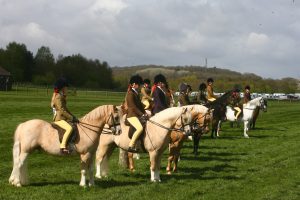
If you’re planning to show a small breed mountain and moorland (M&M) pony in the ring this season, you need to know how to create the best possible picture in the ring and stand out from the crowd. The following judges’ tips will ensure you make an instant impact and help you avoid unnecessary mistakes.
Class options
Mountain and moorland ponies are divided into two categories — small and large. The ridden small breed ponies must be four-years-old and over and registered in the approved pure breed society stud books of Dartmoor, Exmoor, Shetland, and Welsh sections A or B. Riders can be any age.
Two societies govern the small breed championship classes, including qualifiers for Horse of the Year show (HOYS) and Olympia:
- The National Pony Society (NPS)
- The British Show Pony Society (BSPS)
What is a native pony?
M&M ponies form a group of several breeds of ponies native to the British Isles. Many of these breeds are derived from semi-feral ponies kept on moorland or heathland, and some of them still live in this way, as well as many now being kept as fully domesticated animals for riding and driving purposes.
- Shetland ponies come from the Shetland Isles off the northern tip of Scotland
- Exmoor ponies hail from Exmoor in Somerset
- Dartmoor ponies derive from Dartmoor in Devon
- Welsh mountain ponies come from Wales
Riders in native pony classes will be expected to perform an individual show.
Tack and turnout
“Native ponies should be shown with the riders wearing tweed jackets and short jodhpur boots,” says native pony producer and judge Sam Roberts, whose many accolades include the BSPS Heritage supreme championship at Olympia in 2014.
“Make sure your pony has correctly fitted tack and always check breed standards for advice on trimming and showing your native.
“If the breed allows trimming be careful not to detract from their native characteristics.”
9 top tips for showing natives:
1. Bridles should be plain and workmanlike
2. Use plain browbands
3. Either no numnah or one which is discreet and matches the pony and saddle
4. No boots or bandages
5. Brown or black tack: brown is preferred by traditional judges and is always correct in the show ring
6. Snaffle bridles for novice classes
7. Double bridle or pelham for open classes
8. Straight cut or working hunter saddles show more of the shoulder and movement, so are preferable to general-purpose saddles
9. Manes, tails and feathers may be pulled or trimmed for some breeds — but check with the breed society’s specifications
Pitfalls to avoid
1. Badly fitted tack and over bitted ponies
2. Do not use hoof varnish — only hoof oil, which allows the feet to be of natural colour
3. No make-up or hair dying is allowed
4. No false hairpieces
5. Quarter markers are not correct for native ponies
6. “It is considered rude to overtake in front of the judge, as you block his/her view of another competitor,” explains Sam. “Find a space by riding deep corners or overtaking when behind the judge.”
Correct way of going
“Each native breed is unique and different to each other, but we like to see them all going in a way in which they’re happy, relaxed and covering the ground with ease,” explains Sam.
“Each breed has its own characteristics and conformation but every pony differs and this will affect the way the pony goes.”
“If you’re riding a Dartmoor pony it’s unlikely to have the same length of stride as a Welsh section B. Be aware of this and do not push your pony out of his natural rhythm.
“An Exmoor pony won’t be moving the same way as a Welsh section A either, so don’t expect him to keep up in trot — it’s not a race,” continues Sam.
“All of the other breeds maybe taller than a Shetland pony so they will not be expected to keep up in all the paces. However, they are speedy so never underestimate them — especially in gallop!”
Sam stresses that judges want to see native ponies working actively and covering the ground freely — but don’t push them out of their natural rhythm.
“Remember we are showing natives and shouldn’t be cantering like a hack,” advises Sam.
“I like to see them working and looking alert. Native ponies should have a soft outline, working through from behind and over their top line.”
The walk
“Make sure your pony is walking out smartly, with a good length of stride and is tracking up,” says Sam.
The trot
“The trot should be even and regular with good elevation. The pony needs to carry itself and move around the ring without tension or resistance from the rider. The paces should be free-moving and easy on the eye,” adds Sam.
The canter
The canter should be balanced and covering ground in a free and open manner, and always remain in a three-beat.
“The gallop should be a smooth transition where the pony lengthens its stride and stretches over the ground,” explains Sam. “Make sure you gallop all the way along the long side, not just a short burst from the corner.”
Like this? You might also enjoy reading these:
On the day preparation
- “Allow plenty of time when you arrive at the show to check where your ring is,” says Sam
- “If you’re riding a stallion make sure you have a stallion disc on the bridle at all times.”
- Use chalk block for touching up white socks
- Use condition spray for making manes and tails tangle free